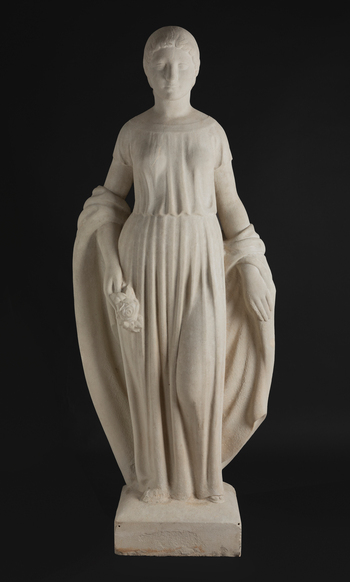Enric Casanovas: paradigm of Noucentisme
The monumental “Flora” by Enric Casanovas, on tender next 13th, represents the paradigm of the noucentista sculptural practice.
After the chaos brought about by the First World War, a need to recover the lost order and balance spreads throughout Europe. This will will end up being the trigger for the return to the classical world, which as a model of civilization will mark the path to follow. This return to what is recognized as the cradle of our culture responds to the imperative desire to reclaim and recover, from the political and cultural sphere, the essence and uniqueness of our own identity .
Under this premise and historical context, a cultural and ideological movement arose at the beginning of the century that united for the first time in Catalonia a group of intellectuals and public authorities with the aim of developing an effective and demanding cultural policy that would return the country to its splendor. Under this alliance, which would receive the name of Noucentisme, a modernizing and Catalanist program was promoted and devised, which materialized through literature and the arts, but also in the scientific and economic development of the territory. The movement, led by Eugeni d’Ors as its main ideologist, laid its ideological and aesthetic foundations through a series of articles published daily by d’Ors himself in “La veu de Catalunya”, The foundation of its ideology is a fervent defense of the classical values of order, reason, precision, clarity and measure, and therefore, a clear recovery of the culture of classical antiquity.ca. Consequently, they reacted against previous trends, such as Romanticism and Modernism, which had the medieval world as a reference point. The exaltation of sentiment and instinct that they championed was replaced by reason and intellect as fundamental pillars in the cultural development of the country.
In the artistic field, and more specifically in sculpture, the noucentista ideology found a magnificent means of dissemination through artists such as Josep Clarà, Manolo Hugué, Aristide Maillol, Joan Rebull and Enric Casanovas, transferred their ideological and aesthetic precepts to bronze, marble or stone. In this sense, the work of Enric Casanovas is one of the fundamental pillars in the renovation of Catalan sculptural practice in the last century, giving shape to a new conception that aspired to define what is properly Mediterranean.
In this aspect, “Flora” stands as a splendid example of the Noucentist postulates, taking as a reference the ideal of Classical Greece, whose serene beauty refers us to a mythical reality. Likewise, Flora is transfigured, as goddess of spring, into an allegory of the fertile land, which, invoking the splendor of ancient civilizations, becomes, in turn, a hymn to the rebirth of her country.
Under this vision, the Barcelona-born artist gave life to a solid and rotund sculptural type in its volumes that, in its synthetic and austere expressiveness, enclosed a remarkable symbolic load, especially latent in female figures, which, like the one we present today, symbolize the paradigm of the style that Casanovas developed. The classical spirit latent in each of his works gave birth to his own concept of Mediterranean sculpture, in which the forms of the human body conquered a timeless, eternal and classic space that made Casanovas one of the most outstanding figures of the national sculptural practice of the last century.






